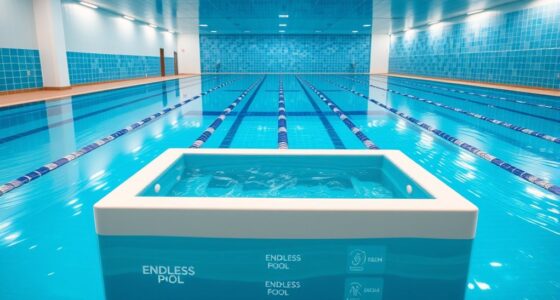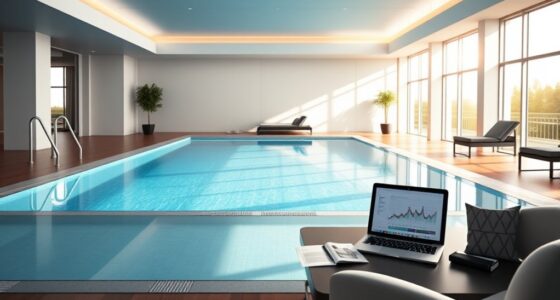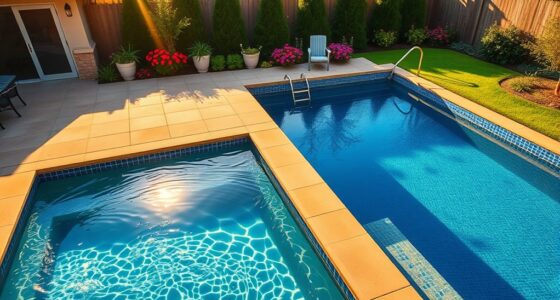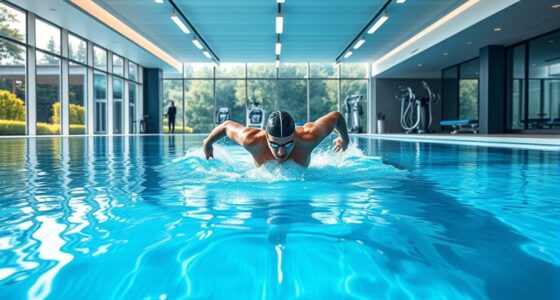If you’re facing minor issues with your endless pool, start by inspecting jets for leaks or cracks and tightening fittings carefully. Check the control panel for loose wires or faults and replace faulty components if needed. Monitor water temperature by calibrating the thermostat or inspecting the heater and sensor. Keep the filtration system clean by replacing filters regularly and removing debris. For lighting problems, ensure bulbs are working and wiring connections are secure. Continue to explore for more solutions to keep your pool running smoothly.
Key Takeaways
- Inspect jets for cracks, debris, or loose fittings; clean or replace damaged seals as needed.
- Turn off the pump before removing and inspecting jets or control panels; reconnect securely.
- Check thermostat and sensors to resolve temperature fluctuations; calibrate or replace faulty parts.
- Clean or replace filtration system components regularly to prevent clogs and maintain water flow.
- Ensure proper wiring and replace damaged bulbs or fixtures when repairing pool lighting.
Troubleshooting and Fixing Leaking Jets

Leaking jets can quickly turn your DIY endless pool project into a frustrating experience, but identifying the source of the leak is the first step to fixing it. Start by inspecting the jets closely for cracks, loose fittings, or damaged seals. Turn off the pump and gently remove the affected jet. Check the O-ring or gasket for signs of wear or debris, which can cause leaks. Clean or replace damaged seals as needed. Tighten loose fittings carefully, but avoid overtightening, which can cause cracks. If the leak persists, consider applying a waterproof sealant around the jet base. Always test the repair by running the pump and observing for leaks. Proper troubleshooting can prevent further damage and extend the life of your pool components and support your understanding of repair techniques. With patience and attention to detail, you can often fix leaking jets without professional help.
Replacing or Repairing the Control Panel

When your pool’s control panel malfunctions or becomes unresponsive, replacing or repairing it is often necessary to restore full functionality. Start by disconnecting power and carefully removing the panel. Check for loose or damaged wires, and replace faulty components as needed. If the issue persists, replacing the entire control panel might be your best option. Before installing a new panel, verify compatibility with your pool model. Properly reconnect all wiring and secure the panel firmly. Test the system to confirm everything works correctly. Keep in mind these key points: Always disconnect power before working on electrical components, handle parts carefully to avoid further damage, follow manufacturer instructions for installation and troubleshooting, and consult necessary cookies to ensure your repair process complies with safety standards.
Addressing Water Temperature Fluctuations

Water temperature fluctuations can disrupt your pool experience, but addressing them promptly can restore consistent warmth. Start by checking the thermostat settings to verify they’re correct and haven’t been accidentally changed. If the temperature seems off, calibrate the thermostat according to your pool’s manual. Next, inspect the heating element for any signs of damage or corrosion; a faulty heater can cause inconsistent temperatures. Ensure the filter isn’t clogged, as poor water flow can hinder heating efficiency. Confirm that the pump is operating properly, since inadequate circulation can lead to temperature swings. If these steps don’t resolve the issue, consider testing the temperature sensor for accuracy or replacing it if necessary. Regular maintenance helps keep your pool warm and comfortable year-round. Additionally, using a filter replacement indicator can help you stay on top of maintenance needs to ensure optimal performance.
Clearing and Maintaining the Filtration System

A well-maintained filtration system is key to keeping your endless pool running smoothly and efficiently. Regularly clearing debris and maintaining the system ensures clean water and peak performance. Start by cleaning or replacing the filter cartridge as needed—clogged filters reduce flow and strain the pump. Check the skimmer basket and remove leaves or debris that can block water flow. Additionally, inspect the pump and filter for leaks or damage, and clean out any dirt or buildup. To keep your system functioning well:
- Clean or replace filters regularly
- Remove debris from skimmer baskets
- Check for leaks or cracks in pump and filter housing
- Fetal movements typically begin to be felt around 18-20 weeks, indicating healthy development.
Consistent maintenance minimizes system failures and extends the lifespan of your equipment, saving you time and money on costly repairs.
Repairing or Replacing the Pool Lighting

If your pool lighting is flickering or no longer illuminating, repairing or replacing the fixtures can restore your pool’s ambiance and safety. First, turn off the power supply to avoid electrical hazards. Remove the pool light fixture carefully, using a screwdriver if needed. Check the bulb for damage or burnout; replace it with a compatible, waterproof bulb. If the fixture itself is damaged, remove and replace it with a new one designed for your pool type. Inspect the wiring for corrosion or loose connections and tighten or replace as necessary. Once everything is secure, test the light before refilling the niche. Regular maintenance and timely replacements make certain your pool remains well-lit, safe, and inviting for nighttime swims. Ensuring proper lighting fixtures and maintaining electrical connections can prevent future issues and extend the lifespan of your pool lighting system.
Frequently Asked Questions
How Often Should I Perform Routine Maintenance on My Endless Pool?
You should perform routine maintenance on your endless pool at least once a month. Regular checks include inspecting and cleaning the filter, testing water chemistry, and ensuring the pump and heater operate smoothly. Weekly, skim the surface and check chemical levels. Proper maintenance keeps your pool running efficiently, prevents minor issues from escalating, and extends its lifespan. Staying consistent with these tasks helps you enjoy a clean, safe swimming experience year-round.
What Safety Precautions Are Recommended During DIY Repairs?
During DIY repairs, you should wear protective gear like gloves and goggles to prevent injuries. Turn off the power supply before starting any work to avoid electrical hazards. Keep the area well-ventilated, especially if using chemicals or adhesives. Use proper tools and follow instructions carefully. Never work alone, and if you’re unsure about any step, consult a professional. Prioritizing safety helps prevent accidents and guarantees a successful repair.
Can I Upgrade My Pool’s Features Myself?
Yes, you can upgrade your pool’s features yourself, but you need to plan carefully, research thoroughly, and follow safety guidelines. Whether adding new jets, installing a heater, or upgrading lighting, guarantee you have the right tools, detailed instructions, and support if needed. Take your time, prioritize safety, and don’t hesitate to consult professionals for complex tasks. With patience and preparation, you can enhance your pool confidently and effectively.
What Are Signs of More Serious, Underlying Pool Issues?
If you notice persistent leaks, unexplained decreases in water levels, strange odors, or cloudy water that won’t clear despite filtering, these are signs of more serious underlying pool problems. Also, listen for unusual noises, check for cracks or structural damage, and monitor your equipment for irregular functioning. Addressing these issues promptly helps prevent costly repairs and keeps your pool safe and enjoyable. If unsure, consult a professional for proper diagnosis.
How Do I Troubleshoot Electrical Problems Safely?
To troubleshoot electrical problems safely, start by turning off the power at the circuit breaker. Use a multimeter to check for proper voltage, but avoid touching exposed wires. Inspect the control panel and wiring for damage or loose connections. If you’re unsure or uncomfortable, it’s best to call a professional. Never attempt repairs with the power on, and always follow safety precautions to prevent shocks or further damage.
Conclusion
With regular DIY maintenance, you can keep your endless pool running smoothly and extend its lifespan. Did you know that proper upkeep can reduce energy costs by up to 30%? Addressing minor issues promptly not only saves you money but also guarantees you enjoy endless fun and relaxation. So, stay vigilant, follow these simple fixes, and your pool will stay in top shape for years to come. Happy swimming!









